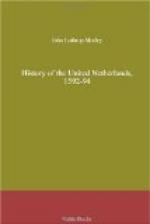Among others, one picture represented Count Peter lying tied hand and foot, while people were throwing filth upon him; Count Charles being pourtrayed as meantime being kicked away from the command of a battery of cannon by, De la Motte. It seemed strange that the Mansfelds should, make themselves thus elaborately ridiculous, in order to irritate Farnese; but thus it was. There was so much stir, about these works of art that Alexander transmitted copies of them to the king, whereupon Charles Mansfeld, being somewhat alarmed, endeavoured to prove that they had been entirely misunderstood. The venerable personage lying on the ground, he explained, was not his father, but Socrates. He found it difficult however to account for the appearance of La Motte, with his one arm wanting and with artillery by his side, because, as Farnese justly remarked, artillery had not been invented in the time of Socrates, nor was it recorded that the sage had lost an arm.
Thus passed the autumn of 1592, and Alexander, having as he supposed somewhat recruited his failing strength, prepared, according to his master’s orders for a new campaign in France. For with almost preterhuman malice Philip was employing the man whom he had doomed to disgrace, perhaps to death, and whom he kept under constant secret supervision, in those laborious efforts to conquer without an army and to purchase a kingdom with an empty purse, in which, as it was destined, the very last sands of Parma’s life were to run away.
Suffering from a badly healed wound, from water on the chest, degeneration of the heart, and gout in the limbs, dropsical, enfeebled, broken down into an old man before his time, Alexander still confronted disease and death with as heroic a front as he had ever manifested in the field to embattled Hollanders and Englishmen, or to the still more formidable array of learned pedants and diplomatists in the hall of negotiation. This wreck of a man was still fitter to lead armies and guide councils than any soldier or statesman that Philip could call into his service, yet the king’s cruel hand was ready to stab the dying man in the dark.
Nothing could surpass the spirit with which the soldier was ready to do battle with his best friend, coming in the guise of an enemy. To the last moment, lifted into the saddle, he attended personally as usual to the details of his new campaign, and was dead before he would confess himself mortal. On the 3rd of December, 1592, in the city of Arran, he fainted after retiring at his usual hour to bed, and thus breathed his last.
According to the instructions in his last will, he was laid out barefoot in the robe and cowl of a Capuchin monk. Subsequently his remains were taken to Parma, and buried under the pavement of the little Franciscan church. A pompous funeral, in which the Italians and Spaniards quarrelled and came to blows for precedence, was celebrated in Brussels, and a statue of the hero was erected in the capitol at Rome.




